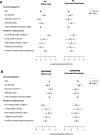The impact of the initial COVID-19 outbreak on young adults' mental health: a longitudinal study of risk and resilience factors
- PMID: 36198725
- PMCID: PMC9533974
- DOI: 10.1038/s41598-022-21053-2
The impact of the initial COVID-19 outbreak on young adults' mental health: a longitudinal study of risk and resilience factors
Erratum in
-
Author Correction: The impact of the initial COVID-19 outbreak on young adults' mental health: a longitudinal study of risk and resilience factors.Sci Rep. 2025 Mar 24;15(1):10119. doi: 10.1038/s41598-025-93618-w. Sci Rep. 2025. PMID: 40128291 Free PMC article. No abstract available.
Abstract
Few studies assessing the effects of COVID-19 on mental health include prospective markers of risk and resilience necessary to understand and mitigate the combined impacts of the pandemic, lockdowns, and other societal responses. This population-based study of young adults includes individuals from the Neuroscience in Psychiatry Network (n = 2403) recruited from English primary care services and schools in 2012-2013 when aged 14-24. Participants were followed up three times thereafter, most recently during the initial outbreak of the COVID-19 outbreak when they were aged between 19 and 34. Repeated measures of psychological distress (K6) and mental wellbeing (SWEMWBS) were supplemented at the latest assessment by clinical measures of depression (PHQ-9) and anxiety (GAD-7). A total of 1000 participants, 42% of the original cohort, returned to take part in the COVID-19 follow-up; 737 completed all four assessments [mean age (SD), 25.6 (3.2) years; 65.4% female; 79.1% White]. Our findings show that the pandemic led to pronounced deviations from existing mental health-related trajectories compared to expected levels over approximately seven years. About three-in-ten young adults reported clinically significant depression (28.8%) or anxiety (27.6%) under current NHS guidelines; two-in-ten met clinical cut-offs for both. About 9% reported levels of psychological distress likely to be associated with serious functional impairments that substantially interfere with major life activities; an increase by 3% compared to pre-pandemic levels. Deviations from personal trajectories were not necessarily restricted to conventional risk factors; however, individuals with pre-existing health conditions suffered disproportionately during the initial outbreak of the COVID-19 pandemic. Resilience factors known to support mental health, particularly in response to adverse events, were at best mildly protective of individual psychological responses to the pandemic. Our findings underline the importance of monitoring the long-term effects of the ongoing pandemic on young adults' mental health, an age group at particular risk for the emergence of psychopathologies. Our findings further suggest that maintaining access to mental health care services during future waves, or potential new pandemics, is particularly crucial for those with pre-existing health conditions. Even though resilience factors known to support mental health were only mildly protective during the initial outbreak of the COVID-19 pandemic, it remains to be seen whether these factors facilitate mental health in the long term.
© 2022. The Author(s).
Conflict of interest statement
ETB serves on the scientific advisory board of Sosei Heptares and as a consultant for GlaxoSmithKline and Monument Therapeutics. SRC receives honoraria from Elsevier for editorial work outside of the submitted work. Previously, he also consulted for Promentis. All other authors declare no competing interests.
Figures






References
-
- Torjesen, I. Covid-19: Mental health services must be boosted to deal with ‘tsunami’ of cases after lockdown. BMJ369, m1994 (2020). - PubMed
Publication types
MeSH terms
Grants and funding
LinkOut - more resources
Full Text Sources
Medical
Miscellaneous

